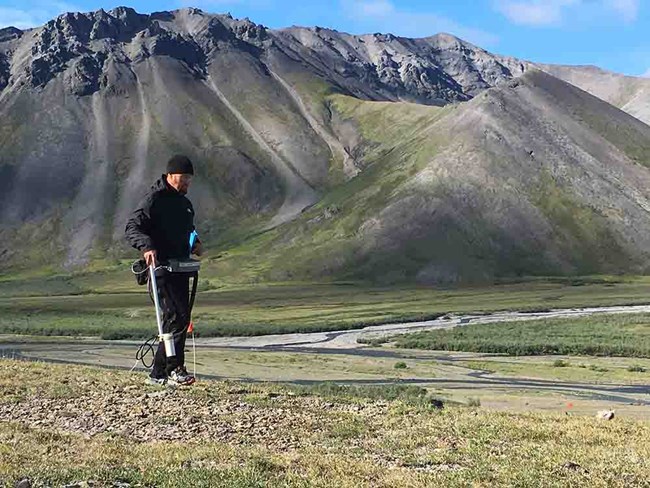Last updated: December 14, 2021
Article
Magnetic Detection of Archaeological Hearths in Alaska

NPS/Jeff Rasic
Archaeologists working across seven national parks in Alaska have used new technology to find old remains and with great success. Magnetic surveying, in effect a highly sensitive metal detector, has proven successful in locating ancient campfires (or hearths). Intense heat from fires creates a magnetic signature that can last thousands of years and is detectable with the proper equipment with a fairly rapid survey of a likely site. The method, furthermore, allows archaeologists to see beneath the ground and target excavations in precise ways for the least impact to sites and the greatest information gain.
A range of hearth types from very small campfires in open air settings, to cooking places within houses, to large, repeatedly used activity areas were detected and delineated. The hearths in this study represent a variety of cultural traditions spanning a 12,000 year period, and include a 1,000-year-old coastal settlement in Bering Land Bridge National Preserve, a 4,000-year-old caribou hunting camp in Yukon-Charley Rivers National Preserve, and a 300-year-old village site in Kobuk Valley National Park.
Hearth features have incredible information value when it comes to understanding the past since they were focal points of human activity and are typically surrounded by artifacts. Perhaps even more importantly they often still contain well preserved charcoal that with radiocarbon dating provides precision estimates for the age of the site. The oldest hearth found in this study, from Noatak National Preserve in northwestern Alaska, dates to more than 11,000 years ago. Found within this hearth, encrusted with charcoal, was a fragment of a large stone spearpoint, likely used for hunting caribou at the end of the last ice age.
Magnetic detection of archaeological hearths in Alaska: A tool for investigating the full span of human presence at the gateway to North America
Abstract
Magnetic survey methods have recently shown tremendous potential for the detection of archaeological hearths in Eastern Beringia, ranging from intermittent open-air camp fires to larger heat intensive activity areas. Here we present an overview of the method along with eight supporting case studies from seven U.S. National Park Service units in the U.S. state of Alaska, covering diverse geographic settings and time-periods. Together, these case studies demonstrate the capabilities of magnetic detection instruments in various modes of operation for finding datable archaeological deposits that span the breadth of known human occupation of this region. The examples range from the simplest use of the magnetometer as a single sensor reconnaissance instrument in a “search mode,” to use as a gradiometer in conjunction with other geophysical methods such as ground-penetrating radar, to record precise measurements and inform nuanced interpretations. Examples presented here range from the terminal Pleistocene to historic periods, spanning 12,000 years of human activity in Eastern Beringia, and encompassing the arrival, emergence, and expansion of multiple human groups or cultural traditions in the New World.
Urban, Thomas M., Jeffrey T. Rasic, Claire Alix, Douglas D. Anderson, Linda Chisholm, Robert W. Jacob, Stuart W. Manning, Owen K.Mason, Andrew H. Tremayne, Dale Vinson. 2019. Magnetic detection of archaeological hearths in Alaska: A tool for investigating the full span of human presence at the gateway to North America. Quaternary Science Reviews 211: 73-92.
Tags
- bering land bridge national preserve
- gates of the arctic national park & preserve
- katmai national park & preserve
- kobuk valley national park
- lake clark national park & preserve
- noatak national preserve
- yukon - charley rivers national preserve
- alaska
- archaeology
- arctic archaeology
- science
- science articles
- science methods
- alaska native
- archeology
